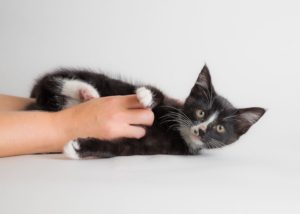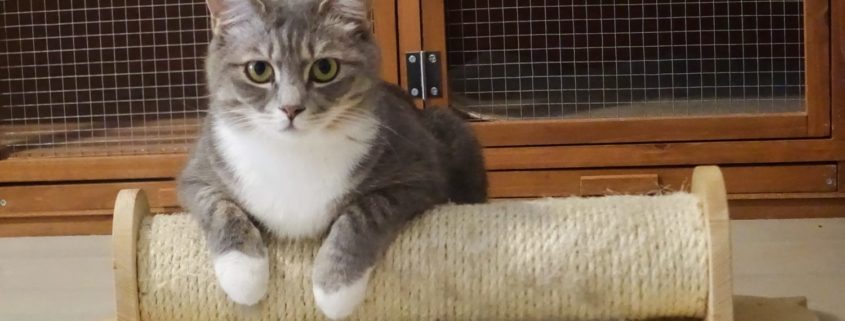Ask Crystal: Healthy Cat Scratching Outlets
Welcome to “Ask Crystal,” where you can ask your pet behavior questions! You can submit your question for Crystal at the bottom of the page!
 Dear Crystal,
Dear Crystal,
I recently adopted a kitten and she is ripping my house to shreds. My couch, my curtains, my carpet are all getting scratched up. I don’t want to declaw her because I heard that is cruel, but I can’t let her ruin my house either. How can I train my kitten not to scratch things?
Sincerely,
Scratched Up
Dear Scratched,
Cat scratching can be a very annoying part of cat ownership, but it is essential part of a cat’s life. Cats scratch for many reasons. It is a way to mark territory with a visual mark and there are also scent glands in their paws to leave scent markers as well. They also need to scratch to keep their claws in good shape and remove the claw sheaths. Scratching is a good way to stretch out stiff muscles and to relive stress. Rather than trying to prevent your cat from scratching, you should teach her where and what to scratch.
Cats have different texture preferences for scratching. Many people report that their cats prefer sisal covered scratching posts. My cats have never touched those type of posts. They prefer carpet covered and cardboard scratchers. There are a number of different materials to choose from such as wood, upholstery, cardboard, carpet or sisal. There are also different orientations for scratchers to choose from such as horizontal, vertical or slanted. You may be able to get some clues to your cat’s preferences from what they are scratching currently. It may also be a trial and error of buying different types and seeing what they will use. Don’t give up on the first try. You should be able to find a type that they like. If you get a vertical post, be sure that it is tall enough for the cat to stretch all the way out and not wobbly. If it topples over while she is trying to use it, it may scare her enough to never use it again.
 There are ways to encourage the cat to use the scratcher once you find her preferences. First, don’t try to force the cat to scratch by grabbing her paws and raking them down the scratcher. You may scare her so that she doesn’t want to use it. We want to encourage her to use it of her own volition. If your cat is one that enjoys catnip, you can spray cat nip spray or rub dry catnip on the scratcher. Research also indicates that cats prefer used scratchers which may indicate that pheromones are attractive to cats. It may be worth a try to spray some Feliway pheromone spray on the scratcher. That also means that you shouldn’t throw your worn scratchers out as the cats like it when they are worn. Playing with the cat around the scratcher may encourage her to interact with it as well. You can try hanging dangling toys off of the posts to encourage her to come over and get on it. Try playing with a cat wand around the post to encourage her to sink her claws into it. You can make the experience even more pleasurable by offering her a cat treat when she scratches at the post.
There are ways to encourage the cat to use the scratcher once you find her preferences. First, don’t try to force the cat to scratch by grabbing her paws and raking them down the scratcher. You may scare her so that she doesn’t want to use it. We want to encourage her to use it of her own volition. If your cat is one that enjoys catnip, you can spray cat nip spray or rub dry catnip on the scratcher. Research also indicates that cats prefer used scratchers which may indicate that pheromones are attractive to cats. It may be worth a try to spray some Feliway pheromone spray on the scratcher. That also means that you shouldn’t throw your worn scratchers out as the cats like it when they are worn. Playing with the cat around the scratcher may encourage her to interact with it as well. You can try hanging dangling toys off of the posts to encourage her to come over and get on it. Try playing with a cat wand around the post to encourage her to sink her claws into it. You can make the experience even more pleasurable by offering her a cat treat when she scratches at the post.
The next consideration should be the locations of the scratchers. Place the scratchers near the furniture arms and other items that the cat is scratching. Unfortunately, cats prefer locations which are out in the open and not hidden. They are marking territory after all. Once the cat is reliably using the scratcher you can begin to gradually move it to a more desirable location. You may also want to put a scratcher near where your cat sleeps as many cats like to scratch when they first wake up. If you have the space, put a scratcher in every room. However, if that is not an option, put them in the areas where you spend the most time.
If the cat is still scratching at undesirable locations, try to deter her by making the texture undesirable. You can try placing double sided tape or foil on the item as most cats don’t enjoy the feeling of those textures. There are citrus sprays that can help deter cats from certain areas since cats do not like the smell of citrus. You may want to spray an enzymatic cleaner on areas where she persists in scratching. This may help to remove the scent from the glands she is leaving which may be attracting her back to those surfaces. Try moving furniture around to block her access to the areas she likes to scratch so she is unable to reach them.
 You may also want to trim your cat’s nails so that there is less need for her to scratch for keeping claws trim. There are also vinyl claw caps called Soft Paws that you can attach to the cat’s claws. They come off naturally as the claws grow so they usually last 4-6 weeks. This is a safe alternative to declawing. Declawing is a procedure that amputates a cat’s toes up to the first joint. There are some very serious complications that can occur due to having this procedure done to your cat. Declawing can in rare occasions lead to secondary contracture of the tendons. The cat overcompensates for the missing joints on her front paws by placing more weight on the back paws which lead her to be out of balance which can cause the front legs muscles to atrophy and strain the rear legs. There are also a lot of behavioral risks to declawing. A recent study in 2017 found that declawed cats are seven times more likely not to use the litterbox. The reason for this is that it might be painful for them to scratch the litter and they then create a negative association with the litterbox. They are also four and half times more likely to bite, three times more likely to be aggressive and three times more likely to over-groom. The aggression could be related to their means of protecting themselves removed and it could also be that they are experiencing pain related to the procedure. Declawing also means that if your cat were to get outside whether accidently or intentionally, they have no way to protect themselves. There are so many reasons not to declaw, it really should not be a consideration to solve scratching problems as the potential problems are so much worse than scratching.
You may also want to trim your cat’s nails so that there is less need for her to scratch for keeping claws trim. There are also vinyl claw caps called Soft Paws that you can attach to the cat’s claws. They come off naturally as the claws grow so they usually last 4-6 weeks. This is a safe alternative to declawing. Declawing is a procedure that amputates a cat’s toes up to the first joint. There are some very serious complications that can occur due to having this procedure done to your cat. Declawing can in rare occasions lead to secondary contracture of the tendons. The cat overcompensates for the missing joints on her front paws by placing more weight on the back paws which lead her to be out of balance which can cause the front legs muscles to atrophy and strain the rear legs. There are also a lot of behavioral risks to declawing. A recent study in 2017 found that declawed cats are seven times more likely not to use the litterbox. The reason for this is that it might be painful for them to scratch the litter and they then create a negative association with the litterbox. They are also four and half times more likely to bite, three times more likely to be aggressive and three times more likely to over-groom. The aggression could be related to their means of protecting themselves removed and it could also be that they are experiencing pain related to the procedure. Declawing also means that if your cat were to get outside whether accidently or intentionally, they have no way to protect themselves. There are so many reasons not to declaw, it really should not be a consideration to solve scratching problems as the potential problems are so much worse than scratching.
I hope these tips are helpful in training your kitten the appropriate items and locations for scratching. Since she is still a kitten and hasn’t had a very long time to form habits, I am hopeful that you can train a more acceptable behavior while keeping your kitty happy.
Until next time,
Crystal







